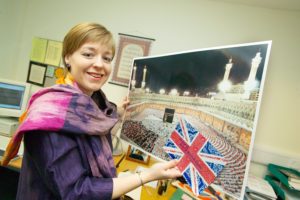
Hearing the voices of ‘everyday’ Muslims
I ended my last blog entry by noting the value of inter-religious relationships formed among students learning about Islam in the higher education environment. Continuing with this theme, one of the consequences of this mixed-faith, or Muslim/non-Muslim learning environment is the opportunity for students to situate their learning about Islam within the context of engagement with, and learning from, fellow students as ‘ordinary’ Muslims. Why is this important?
There has been a noticeable expansion of the professional field of ‘Islamic Studies’ in the last decade. Academic publishers have developed their lists; new professional associations have been formed (e.g. ‘BRAIS – British Association for Islamic Studies, established in 2014); and, new modules and academic programmes have been validated. Alongside these developments there has been a growth of new empirical social scientific research, with particular focus upon ‘issues’ facing Muslim communities in diasporic settings. Fortunately, the reflexive turn in anthropology and social science is shaping some of the outputs of these studies, and researchers are appropriately and self-critically reflecting upon questions of positionality, access, gatekeepers, and ethics.
Welcome though this expansion of knowledge production and engagement is, it is nevertheless the case that public, media, or academic understanding of Muslim communities is shaped by what is publicly and increasingly available on TV, in the library or bookshop, or online. These productions may fall across a spectrum of quality, from sensationalist investigative journalism at one end, to high quality scholarly research on the other. But it is inevitable that some research topics are more ‘fundable’ than others; some radio or TV shows are more likely to be commissioned than others, based on consumer demands and appetites. Consequently, the contemporary production of knowledge about Islam and Muslims is shaped by a wide ranging set of personal, professional, economic, political and academic interests; and ‘interests’ are rarely ‘neutral’ or value-free.
One of the outcomes of all this can be the ‘framing’ of Muslims through particular and sometimes potentially distorting lenses in ways that can confuse non-Muslims, and frustrate those with Muslim identities. The contributors to media or academic projects are most likely to fall into a particular category, such as the articulate ‘official’ spokesperson; the individual with an axe to grind; those with prominent media (and especially social media) profiles; those who are visible/accessible by virtue of their membership of a particular Islamic organisation or community group; and, simply, those who have time to spare to give an interview to a researcher or journalist.
So the voices we hear, or the books or articles we read about Islam and Muslims are sometimes a long way from the ‘lived’ experience of Muslims going about their daily lives, and can tend to focus upon a particular set of ‘fundable’ topics. So, while it is important to understand the reasons why a proportionally minute number of extremists carry out acts of terrorism, based on misguided Islamic motivations, the degree of attention given to this subject inevitably skews the field of research and debate, overall. The seemingly endless conversation about Muslim dress codes (for women) can tend to distract research attention from the daily realities of women’s lives, and the structural inequalities that may be detrimental to their well-being and flourishing. Are Muslim women only interesting because of what they look like, or what they wear? Of course not, but the volume of research and media debate about Muslim women’s dress might suggest otherwise.
The mixed-faith classroom gives non-Muslim students an opportunity to appreciate fellow Muslims as ‘normal’ human beings, who, like themselves, are often preoccupied with academic grades, future career choices, what to eat for dinner, who to marry, or where to live. The academic classroom and adjacent coffee-room can provide a context for normalising Muslim/non-Muslim relations, thereby placing shared ‘everyday’ human experience at the centre of mutual learning. This may not make good newspaper copy or exciting viewing, nor is it likely to offer particularly rich research data; but it is the bread and butter of nourishing human conversation and an important counterbalance to a research field that has been caught up in the tumult of tragic world events. Irrespective of students’ religious identities, an appreciation of these dynamics, and an ability to critically evaluate the process of knowledge production about Islam and Muslims is an important duty of teachers in the Islamic Studies field today.